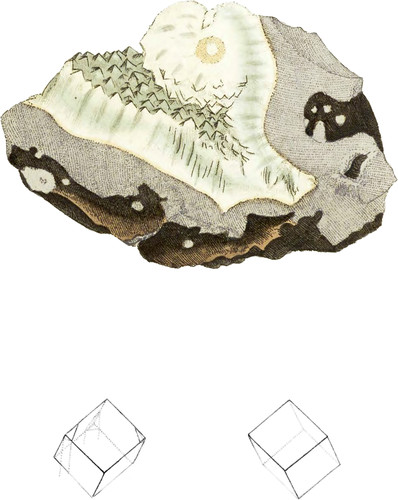 Enlarge
Enlarge
British Mineralogy
Primitive crystallized Quartz
- Class 2. Earths.
- Order 1. Homogeneous.
- Gen. 6. Silex.
- Spec. 1. Quartz
- Div. 1. Crystallized.
- Var. 1. Primitive
- Gen. Char. Rough and harsh to the touch. Soluble in the two fixed alkalis; but in no acid but the fluoric, except (as some think) when in combination with an alkali, much diluted with water; also soluble in 1000 times its weight of water.
- Spec. Char. Nearly uncombined. Burns to an opaque white. Spec. grav. 2.64 to 2.67. Kirw.
- Syn. Quartz. Kirw. 1. 242.
Haüy says that the primitive crystal of Quartz is the slightly obtuse rhomb, measuring 94° 4′ and 85° 56′. He does not seem to have met with a specimen. Mine, which is formed in a variegated flint, from Lewisham in kent, showing only one end of the rhomb, agrees with this description, as the primitive: some of them show signs of the other three faces, approaching the double hexaëdral pyramids. See the left hand figure.
Silica when transparent and crystallized is commonly called Quartz, Rock Crystal, or Mountain Crystal; the purest are generally colourless, and often very brilliant. They were formerly much esteemed, and known by the jewellers under the name of Rock Crystals, and Scotch, Welch, or Cornish Diamonds; nor do jewellers seem to distinguish between Rock Crystal and Quartz, although they chiefly use Rock Crystal.
It is sometimes found yellowish, or of a topaz colour, passing to red, purplish, brown, black, &c. Its lustre is glassy; it is more or less transparent, and is said by most authors to have a double refraction: we, however, could not discover this circumstance. The fracture is coarse, splintery, conchoidal, or undulating, the flaws frequently iridescent. Hardness 10. Kirw. brittle, strikes fire with steel, and scratches glass. It is the chief ingredient in making glass, when fused with potash, soda, &c. and seems to be only a purer kind of flint. Diamond has generally been classed as the first species of Silex, but it has at length been discovered to be the purest species of Carbon. Quartz seems very properly distinguished from rock crystal by Mr. Kirwan. The former if exposed to a strong red heat becomes of an opaque white: this specimen is therefore truly quartz, as I have proved by trying a fragment, which being exposed to a strong heat in a common fire became first of an opaque white, and by longer exposure somewhat opaline, or rather like chalcendony; not unlike common flint under similar circumstances. Rock crystals on the contrary, originally dark brown, &c. by the same heat becomes beautifully transpraent, as some lapidaries and jewellers well know.

